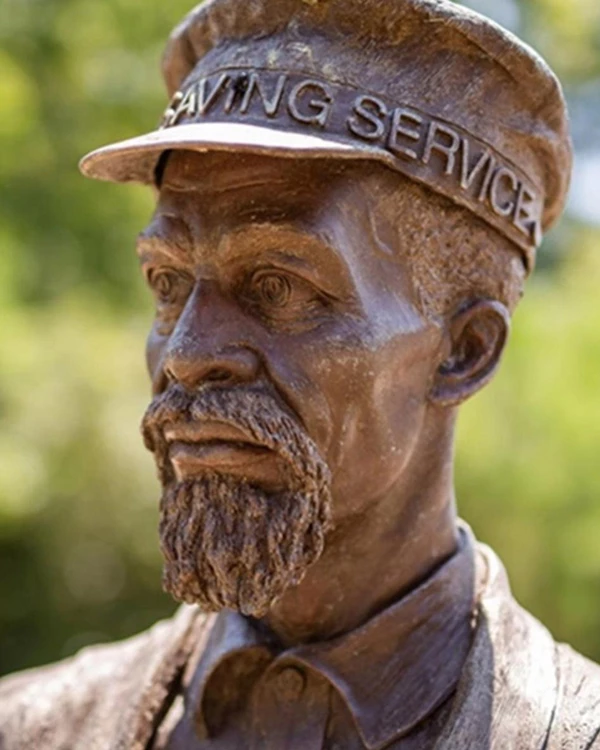Last updated: April 30, 2025
Person
Richard Etheridge

Early Life, Civil War, and the Freedmen's Colony:
Richard Etheridge was born on North Carolina’s Roanoke Island on January 16, 1842. Thought to be the son of his owner, John B. Etheridge III, Richard had an unconventional experience as an enslaved person - he was raised within the Etheridge household and was educated having been taught by the family how to read and write. His mother, Rachel Dough, was enslaved by the Etheridge family on Roanoke Island. After the U.S. Army captured Roanoke Island from the Confederacy after the Battle of Roanoke Island, Richard was emancipated and became a member of the Roanoke Island Freedmen's Colony.In 1863, During the American Civil War, Etheridge joined the Union war effort, serving in the 36th U.S. Colored Infantry until 1866. Afterwards, Etheridge returned to Roanoke Island, married in 1867, and worked as a fisherman, farmer, and inlet pilot. Skills amassed from his wartime service and making a living in the Outer Banks contributed to Etheridge’s success when he made the life-altering decision to join the United States Life Saving Service (USLSS) in 1875.
From Surfman #6 to Keeper
Etheridge first served on the Bodie Island USLSS crew as Surfman #6 – the lowest ranking surfman. At the time, the USLSS did not allow African Americans to hold a higher rank in integrated “checkerboard” crews. While at Bodie Island, Etheridge honed his skills through the rigorous drilling which became synonymous with the Life Saving Service. His persistence, skill, dedication, and education did not go unnoticed. In 1879, the keeper of Pea Island Life Saving Station was relieved of duty after an extensive investigation into the ineffectiveness of the Outer Banks Life Saving Stations following a succession of failed rescue attempts. Persuaded by the recommendations of the district inspectors, USLSS Superintendent Summer Kimball appointed Richard Etheridge as Keeper of the Pea Island Life Saving Station, making Etheridge the first African American to serve in this position.The Pea Island Lifesavers and the Rescue of the E.S. Newman
When Etheridge assumed command of the Pea Island Life Saving Station in February 1880, the unit underwent an upheaval as the station’s white crewmembers resigned refusing to serve underneath him. Subsequently, African American surfmen from nearby units were transferred to Pea Island, forming the first and only all-black crew in the United States Lifesaving Service.
Etheridge ran a tight ship and commanded what has often been described as the best crew in the Outer Banks. Their training was put to the test on the night of October 11, 1896, when the E.S. Newman, a schooner sailing from Providence, Rhode Island, grounded off the coast during a terrible hurricane. Unable to launch the lifeboat or fire the Lyle Gun, Etheridge turned to sheer manpower as his final option. Asking for two volunteer crewmen, Etheridge commanded they tie ropes around themselves and swim to the wreck, the remaining crew on shore would hold the ropes as a lifeline between land and sea. That night, the Pea Island crew rescued all nine aboard the E.S. Newman, including the captain’s wife and his three-year-old son. For their efforts, Etheridge and his crew were posthumously awarded the U.S. Coast Guard’s Gold Life-Saving Medal in 1996.
Remembering a Life of Service
Captain Richard Etheridge passed away at the Pea Island Life Saving Station in 1900 at the age of 58. He is buried alongside his family at the Pea Island Life Saving Station Memorial on the grounds of the North Carolina Aquarium on Roanoke Island. The Pea Island Life Saving Station continued to operate with an all-black crew until it was decommissioned in 1947. Today, the only remaining structure from the unit is the Pea Island Cookhouse, preserved by the Pea Island Preservation Society. The cookhouse is now a museum dedicated to Richard Etheridge and the Pea Island crew.On August 3, 2021, the United States Coast Guard commissioned one of its Sentinel-class cutters named the USCGC Richard Etheridge in his honor. The vessel is based in Miami, Florida, a reminder of the man who dared to challenge the norm and commanded one of the finest crews in the history of the United States Life Saving Service.
